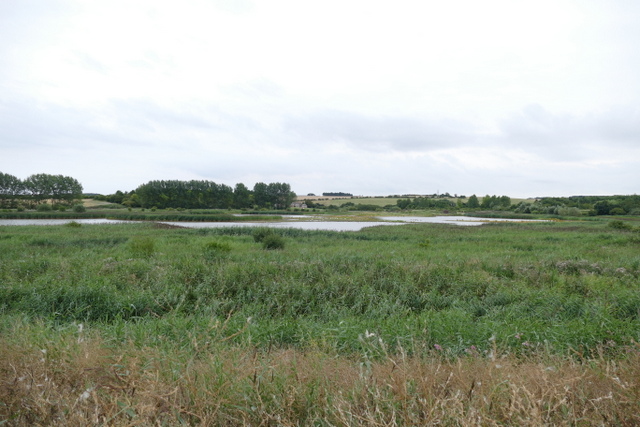A Private Tour today. With autumn just around the corner and waders already moving south in some numbers at this time of year, we headed out to explore the coast and try to familiarise ourselves with the wide variety of shorebirds passing through.
Our first destination was Titchwell, but we made our way there through the agricultural hinterland behind the coast, so avoiding the congestion that often marks the main coast road in the summer. The wheat is ripe and golden brown now and where it had been harvested we found Brown Hares in the stubble. At Choseley, we stopped briefly to admire a golden-headed male Yellowhammer feeding along the edge of the road. The hedge nearby was being raided by a noisy rabble of Starlings, their gathering numbers another harbinger of the impending end of summer.
Down at Titchwell, we headed straight out onto the reserve. The verge along the sea wall by the main path was full of insects. We stopped to admire a yellow female Common Darter dragonfly on the brambles and several butterflies, including several Gatekeepers and a few now rather faded Meadow Browns. A Wall butterfly perched rather obligingly – and appropriately – on one of the signs on the sea wall.
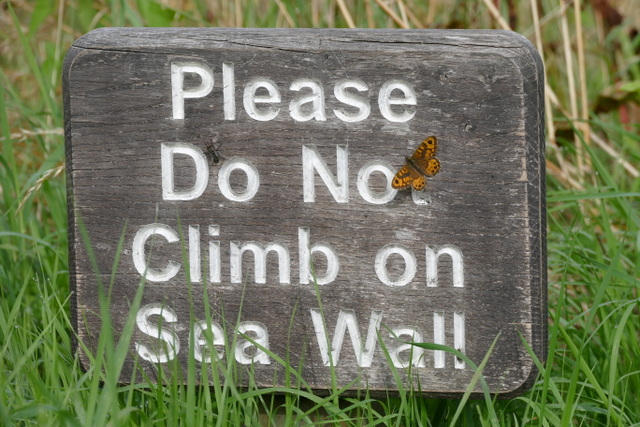 Wall – on a rather appropriate sign
Wall – on a rather appropriate sign
There was a nice selection of commoner ducks on the reedbed pool, all in rather drab eclipse plumage now, including Gadwall, Teal and Shoveler. Amongst them, we found three female Red-crested Pochards – their dark brown caps and paler cheeks setting them apart. Diving constantly were a couple of Tufted Ducks and a female Common Pochard as well. As well as ducks, the juvenile Great Crested Grebe was still present, still sporting its stripy head, and a couple of well grown young Little Grebes were being fed by one of their parents along the edge of the reeds. A Water Rail squealed from deep in the reedbed.
The freshmarsh was looking as inviting as ever and thronged with waders. There have been record numbers of Avocets on the freshmarsh in the last month or so and there was still an impressive number today – at least 300. We made our way into Island Hide and the mud in front was full of Dunlin. The default ‘small wader’, we spent some time looking closely at them. The majority now are juvenile birds, with white bellies variably speckled with black. Amonst them, we could see a smaller number of adult Dunlin, still sporting the bolder black belly patch of their summer plumage.
 Dunlin – most of the birds present today were juveniles
Dunlin – most of the birds present today were juveniles
In amongst the Dunlin, right in front of the hide, were several Ruff. As with the Dunlin, there are more juvenile birds around now, with brighter scaled backs and breasts ranging from deep buff to burnt orange. Amongst them, we could still find several adult Ruff, now mostly in winter plumage, much greyer above and whiter below than the juveniles. Still a couple of tardy males were sporting the last remnants of their bright summer plumage, though looking a bit scruffy now as they finish their moult.
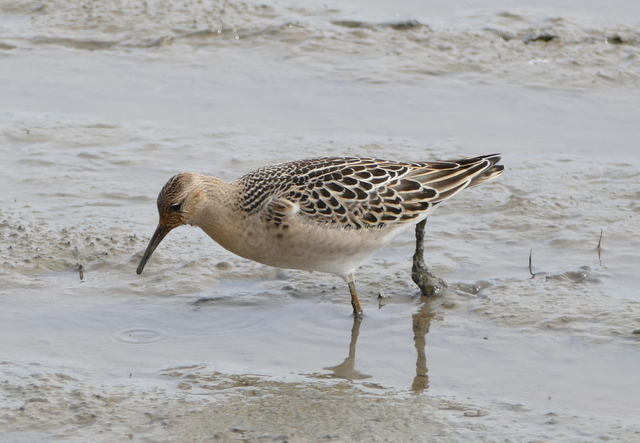 Ruff – a scaly-backed, buff-breasted juvenile
Ruff – a scaly-backed, buff-breasted juvenile
The godwits were mostly asleep on one of the islands, mostly Black-tailed Godwits at this time of tide. The majority of the Black-tailed Godwits we see along the coast here are birds from Iceland (the islandica subspecies), but amongst them we occasionally get Continental Black-tailed Godwits (the limosa subspecies). Amongst the moulting adult and 1st summer Icelandic birds, we found a single juvenile of the Continental subspecies, much plainer and greyer than the brighter rusty juvenile islandica nearby.
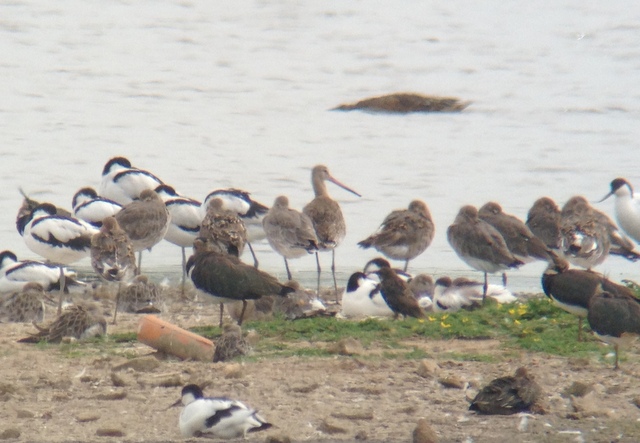 Continental Black-tailed Godwit – the tall, lanky juvenile in mid-photo
Continental Black-tailed Godwit – the tall, lanky juvenile in mid-photo
There were some scarcer species of wader in amongst the commoner hordes as well, and with some patient scanning we gradually found them. A larger, longer necked bird in amongst the Dunlin was clearly different. A closer look confirmed the bright spangled upperparts and pale supercilium of a Wood Sandpiper. A second Wood Sandpiper was lurking at the back of the freshmarsh with a small group of Ruff – noticeably smaller and sleeker than those.
Also among the Dunlin was a much smaller wader, similar in general colour above but paler below and lacking the black belly patch or streaking and with a rather short, fine bill – a Little Stint. While the Dunlin were generally feeding out in the water or wetter mud, the Little Stint was mostly running around on the drier edges of the islands.
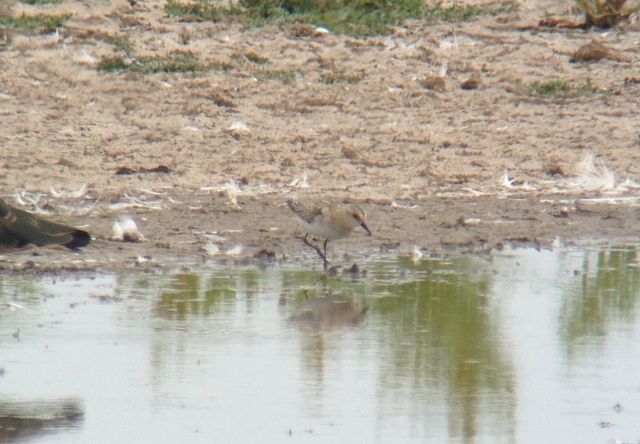 Little Stint – a tiny wader, hiding in amongst the Dunlin flock
Little Stint – a tiny wader, hiding in amongst the Dunlin flock
We also located a couple of Little Ringed Plovers amongst the smaller waders. Lacking the bold black and white head pattern of adults, these were young birds but we could still see the ghosting of the adult’s distinctive golden-yellow eye ring. A single Ringed Plover was out on the freshmarsh as well. A couple of Golden Plover appeared from amongst the vegetation on one of the islands with the Lapwing, but didn’t linger. However, on our way back later a much larger group of Golden Plover had appeared, presumably from feeding inland, and was bathing and preening back on the islands.
 Little Ringed Plover – a couple were still on the freshmarsh
Little Ringed Plover – a couple were still on the freshmarsh
While we were in Island Hide, we could hear the pinging of Bearded Tits continually from the reeds. Several juveniles have been in the habit of feeding out on the mud in recent weeks, but there was no sign of them at first. A couple of Reed Warblers were feeding low down on the edge of the reeds. Only once we were back up on the main path did they appear – four rich, tawny coloured juvenile Bearded Tits, one of them still with only part grown tail. We got a good look at them in the scope.
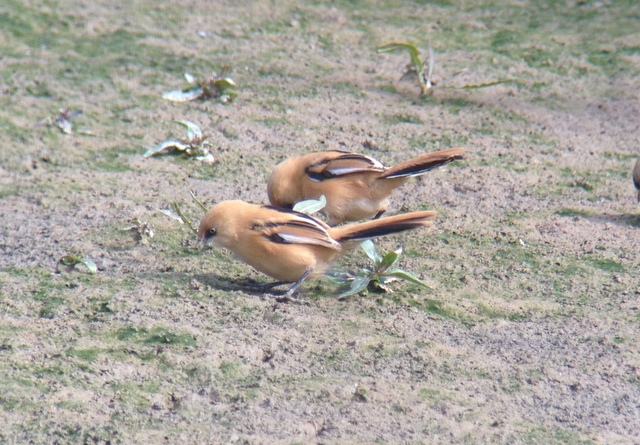 Bearded Tits – the juveniles on the mud, taken a couple of days earlier
Bearded Tits – the juveniles on the mud, taken a couple of days earlier
While we were up on the sea wall, the waders suddenly took flight and started whirling round calling. A look overhead revealed a falcon high in the sky. It was quickly joined by a second and the two of them circled over the water, a pair of Hobbys. Their mere presence caused pandemonium below, before they drifted off out of view. Out across the saltmarsh a couple of Marsh Harriers circled.
The Spoonbills have had another successful breeding season in Norfolk and the juveniles, together with their accompanying parents, can still be seen gathering at several sites along the coast. We could see a small group over the back of the freshmarsh when we first arrived, but there was no sign of them from Island Hide. They have a habit of walking round the back of the furthest island to sleep out of view. And Spoonbills do like to spend a lot of time sleeping! We got a better view of them from round at Parrinder Hide, 10 in total. They even woke up on occasion!
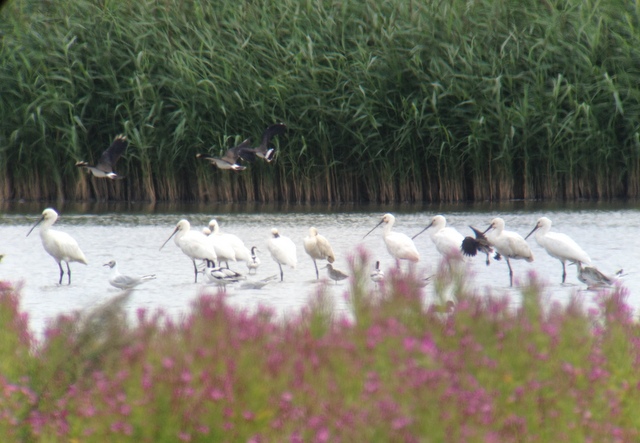 Spoonbill – 10 this morning, during one of their waking moments
Spoonbill – 10 this morning, during one of their waking moments
We added a couple more waders to the day’s list from round at Parrinder Hide as well. In the deeper water at the back, we could see several Spotted Redshanks. Now mostly in winter plumage, much white below and paler silvery grey above than Common Redshank an with a longer needle-fine bill. A couple of Bar-tailed Godwits dropped in with the Black-tailed Godwits – in winter plumage, they were clearly paler and we could see their more streaked upperparts.
The Volunteer Marsh was mostly quiet, apart from a few Common Redshank and a couple of Curlew. However, a quick scan along the tidal channel revealed a very smart Grey Plover, still sporting the black belly and face of summer plumage. There were a couple more Grey Plover on the tidal pools, though one already lacking its black belly and the other moulting it out. Amongst the gathering of Common Redshank, we also found a single Greenshank luring at the back.
As we walked out to the beach, we could hear and see flocks of waders flying up and heading in behind us. The tide was on its way in but this still seemed a little early and when we got out there we could see why, with lots of holidaymakers clambering over the rocks. There were still a few Turnstone, still looking stunning in their brighter summer plumage, plus several Oystercatcher and Bar-tailed Godwits. Further along the beach towards Brancaster, where it was quieter, there was a small flock of Sanderling running in and out of the incoming tide. The sea itself was quiet. A couple of male Common Scoter were swimming past offshore and few Sandwich Terns fishing.
As we headed back to the car for lunch, we stopped briefly to look at the freshmarsh again. Many of the waders which had been disturbed from the beach were now bathing and roosting there. In particular, there was a much larger flock of Bar-tailed Godwits and a scan through them also revealed a few Knot. Several were still in summer plumage, with bright orange underparts, but one was in the more familiar grey non-breeding plumage which is how we normally see them here during the winter months.
In the afternoon, we headed back along the coast to Stiffkey Fen. The hedgerows along the path were nicely overgrown and full of butterflies. Mostly Gatekeepers again, but amongst them we saw a very faded Ringlet as well.
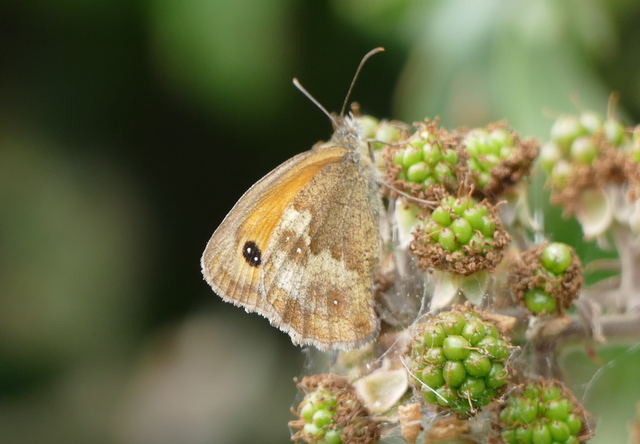 Gatekeeper – the overgrown hedgerows were full of them today
Gatekeeper – the overgrown hedgerows were full of them today
As we approached the Fen we could immediately see a large gathering of white shapes on the islands. More Spoonbills, and yet again most of them were asleep. One was feeding rather tentatively in the shallows and as it lifted its head we could see the shorter, paler bill of a juvenile, one of the young born this year. From up on the seawall, we got a chance to count them, a grand total of twenty in all.
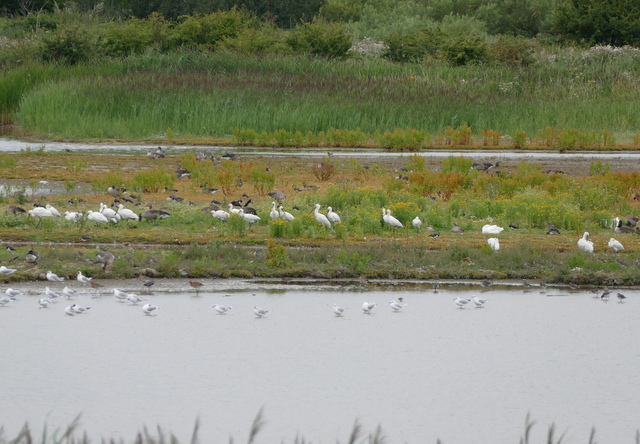
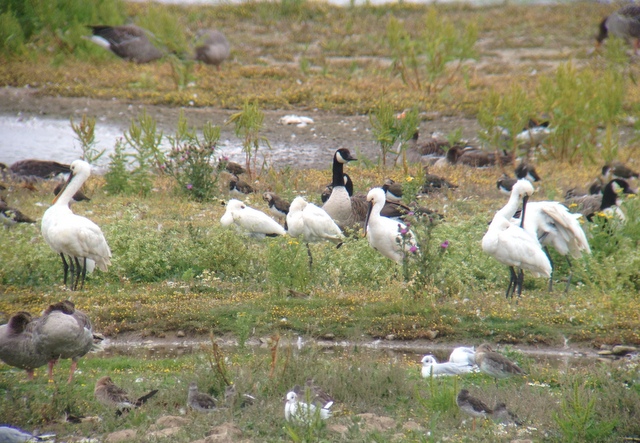 Spoonbill – a total of 20 at Stiffkey Fen today, mostly asleep!
Spoonbill – a total of 20 at Stiffkey Fen today, mostly asleep!
As we scanned over the Fen from up on the sea wall, two of the Spoonbills set off for a walk round. It was immediately obvious that one was pursuing the other and a quick look showed it was one of the juveniles chasing after an adult bird. The juvenile Spoonbills are relentless, begging from their parents when they want to be fed, chasing after them flapping their wings and bouncing their heads up and down. Every time we looked back, the two were still walking round and round the Fen.
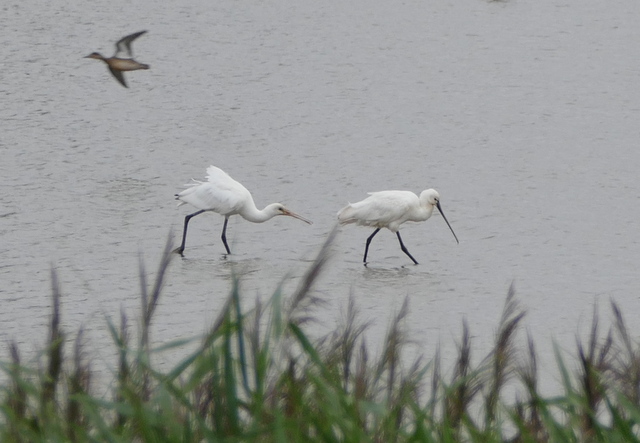 Spoonbills – a ‘little beggar’ juvenile chasing after a parent
Spoonbills – a ‘little beggar’ juvenile chasing after a parent
We could hear Green Sandpipers calling as we walked out, but there was no sign of them on the Fen when we got there. They played hide and seek for a while, occasionally flying round calling before landing out of view, until they finally gave themselves up and landed at the front. We saw at least three, but there could easily have been more. As we got onto the seawall, there were two Common Sandpipers on the muddy edge of the tidal channel beyond, and they disappeared upstream out of view. Later, as the tide rose and the mud disappeared, they flew back out and onto the Fen. We could see the diagnostic white spur between the grey breast and wings.
As the tide rose in the harbour, the Greenshank started to fly into the Fen as well. First one arrived, calling loudly. As we stood there more dropped in. Eventually a little group of 5 stood together on the edge of one of the islands at the back. There were other commoner waders here as well, a flock of Black-tailed Godwits and Redshank, together with a few Ruff. In amongst the legs of the larger waders, 2-3 Dunlin were feeding. Avocets breed on the Fen and a pair were obviously still feeling protective, even though we could not see if they had any young. Every few minutes they would fly up off the Fen and over towards the sea wall, calling, occasionally coming low overhead.
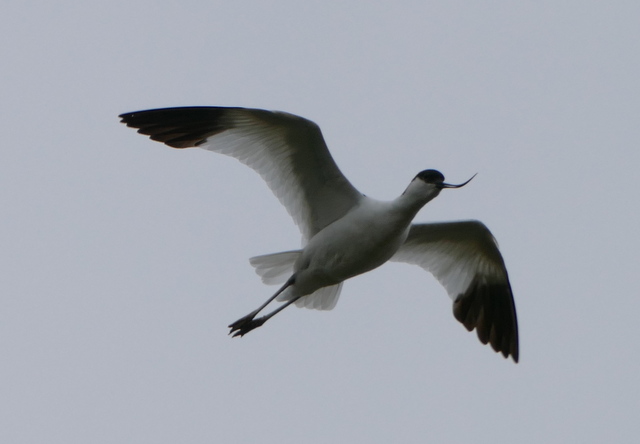 Avocet – a pair of adults repeatedly flew over us on the sea wall
Avocet – a pair of adults repeatedly flew over us on the sea wall
The Spoonbills started to become a bit more active as we stood there, and several flew off over our heads and out towards the saltmarsh. At one point, an adult flew over followed by two juveniles – presumably a family group.
 Spoonbill – great flight views as birds headed out to the saltmarsh
Spoonbill – great flight views as birds headed out to the saltmarsh
With the tide rising, we walked on round to have a look in the harbour. A Kingfisher called and flashed across the reeds, disappearing into the river channel. A short while later, round at the harbour, it reappeared – flying out along the tidal channel beside us in a flash of electric blue and disappearing towards the ‘Pit’.
There were not so many waders left, with the tide covering most of the mud. As we walked round, we could hear Whimbrel calling and picked up a couple of good sized flocks flying high over the harbour, heading west presumably to roost. Several Curlew were also heading the same way. There were little groups of Oystercatcher gathered round the edge with a few Turnstone amongst them. A few waders landed out on the last remaining sandbar. Through the scope we could see several Grey Plover, most still sporting smart black bellies, and a couple of Bar-tailed Godwits with two smaller Knot in amongst them. Two even smaller Dunlin flew in as well, but all were quickly pushed off by the tide.
Then it was time to head back, pausing briefly to admire a stunning red-breasted male Linnet. There was time for one more surprise. As we passed the Fen, a small wader flew in and landed on the edge of one of the islands out of view. Working our way round to where we could see it, we found a Little Stint feeding with the two Common Sandpipers. A lovely way to end – a great day out with a particularly nice selection of waders.
